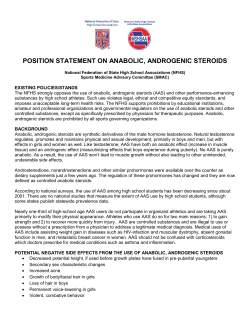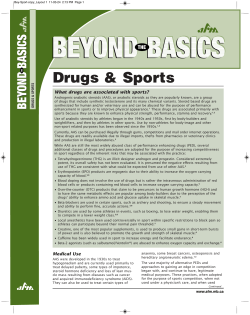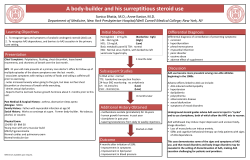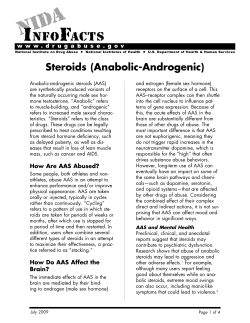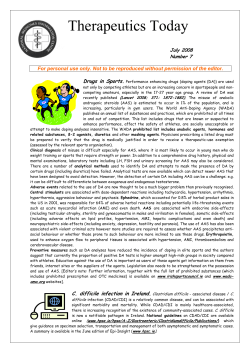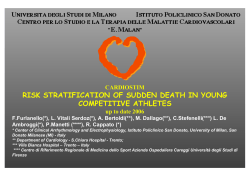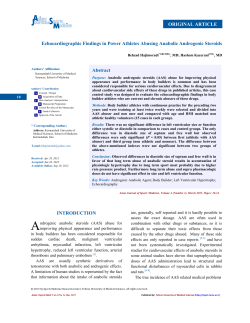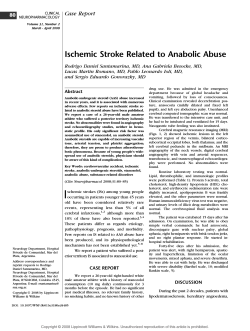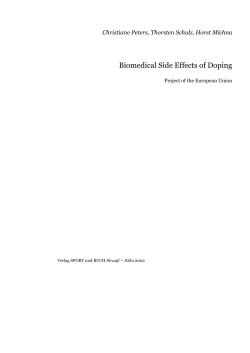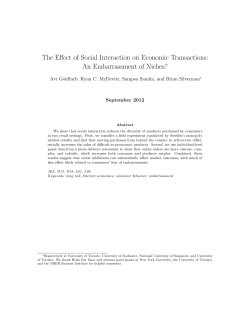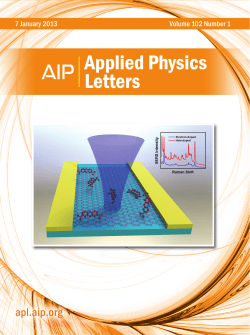
Review Use of doping agents, particularly anabolic steroids, in sports and society
Review Use of doping agents, particularly anabolic steroids, in sports and society Folke Sjöqvist, Mats Garle, Anders Rane Lancet 2008; 371: 1872–82 Karolinska Institutet, Department of Laboratory Medicine, Division of Clinical Pharmacology, Karolinska University Hospital, Stockholm, Sweden (Prof F Sjöqvist MD, M Garle, Prof A Rane MD) Correspondence to: Prof Folke Sjöqvist, Karolinska Institutet, Department of Laboratory Medicine, Division of Clinical Pharmacology, Karolinska University Hospital, Huddinge, SE-141 86 Stockholm, Sweden folke.sjoqvist@ki.se For the World Anti-Doping Agency see www.wada-ama.org 1872 The use of doping agents, particularly anabolic androgenic steroids (AAS), has changed from being a problem restricted to sports to one of public-health concern. We review the prevalence of misuse, the evidence that some drugs improve performance in sport, their side-effects, and the long-term consequences of AAS misuse for society at large. There is substantial under-reporting of the side-effects of AAS to health authorities. We describe neuropsychiatric side-effects of AAS and their possible neurobiological correlates, with particular emphasis on violent behaviour. Analytical methods and laboratories accredited by the World Anti-Doping Agency can detect the misuse of all doping agents; although the analysis of testosterone requires special techniques, and recently discovered interethnic differences in testosterone excretion should be taken into account. The prevention of misuse of doping agents should include random doping analyses, medical follow-ups, pedagogic interventions, tougher legislation against possession of AAS, and longer disqualifications of athletes who use AAS. Prevalence of doping in sport and society The use of pharmacologically active substances to improve performance in work or sports goes back centuries but has increased in the past 40 years since the introduction of anabolic androgenic steroids (AAS; table 1).1–7 In an article entitled “The toxic torch of the modern Olympic Games”, Prendergast and coauthors state that the quest for greatness has driven many athletes and coaches to push for unfair advantages by the use of performance-enhancing (ergogenic) drugs, commonly referred to as “doping”.6 After the reunification of Germany, the horrifying features of the doping of Olympian competitors in the former East Germany were revealed.7 The use of doping agents is no longer restricted to competing athletes; young sportspeople in schools and non-competing amateurs also use them. Misuse of AAS is increasing among gym customers for whom bodily appearance is a priority. Estimates of misuse have to be interpreted with great caution due to the difficulties of reliable studies of illicit drug use. In the USA, between 1 million and 3 million people are thought to have misused AAS;8,9 the estimate for Sweden is 50 000– 100 000, among a population of 9 million. These estimates roughly equate to 1% of the respective populations. Interviews of high-school students in several European countries and the USA reveal that 1–5% have used AAS, but this measure is of doubtful relevance for the population at risk of serious side-effects, which develop during long-term use.10 An investigation of 6000 Swedish people age 16–17 years with an anonymous multiplechoice questionnaire revealed that 3·2% of males had used AAS, but none of the females had.11,12 There was an association between the misuse of AAS and the use of substances such as alcohol, growth hormone, and narcotic drugs. In males, visible results of physical training were thought important for self-confidence, respect from girls, and security in nightlife and beach culture.13 An informational intervention programme led to a decrease of almost 50% in misuse in males.14 Much higher estimates of misuse of AAS have been obtained in groups such as bodybuilders, weight-lifters, and prison populations.10 A German study assessed the use of AAS among visitors to fitness centres by use of anonymous questionnaires. Although only 34·5% of these were returned, 13·5% in this selected group reported that they had used AAS at some point.15 In this study, only 3·9% of women had used AAS, and studies in Great Britain and the USA have found similar levels of use among women.16 The best estimates of stimulant drug misuse are available for ephedrine. Ephedra alkaloids are popular components of many nutritional supplements and are also used as stimulants on their own. As many as 2·8 million US recreational athletes might have used ephedrine in 2001.16 Since 1993, the Swedish government has sponsored the antidoping hotline—a telephone service answering questions about doping from anonymous callers involved in or exposed to doping.17 Between 1993 and 2006 the organisation received about 40 000 calls. Callers connected with gyms were the largest group (30%). Most calls were about AAS such as testosterone, nandrolone decanoate, methandienone, and stanozolol (table 2). Substances prohibited in sports The World Anti-Doping Agency (WADA) publishes a yearly list (panel 1) of substances and practices prohibited at all time in and out of competition. When prescribing listed drugs, physicians must be prepared to verify that the drug is medically justified and can be given a therapeutic-use exemption,18 a decision that requires assessment by the relevant sports organisation. As an example, a therapeutic-use exemption is needed if a β2-adrenoceptor-agonist or corticosteroid inhalation is prescribed for bronchoconstriction.19 There are different rationales for including a drug on the WADA list. The original idea was to list drugs known or suspected to improve performance in sports. After www.thelancet.com Vol 371 May 31, 2008 Review confrontation with the realities of doping, other reasons were accepted, such as the safety of the athletes, social unacceptability, and attempts to make doping analyses insensitive. Anti-oestrogens are on the list because they are sometimes used to antagonise the oestrogenic side-effects of AAS and other drugs. There is also a list of substances prohibited in competition (panel 2). Alcohol is prohibited only in certain sports (eg, racing with automobiles and motorcycles). β blockers are prohibited in sports in which absence of a high pulse rate and tremor is advantageous (eg, shooting). Prohibited practices in sports include enhancement of oxygen transfer (eg, blood doping), chemical and physical manipulation of samples collected during doping controls, and gene doping to administer erythropoietin or other genes that might affect athletic performance, which is a possible future development. Blood doping is any method or substance used for non-medical purposes that improves aerobic performance by increasing oxygen flow to peripheral tissues in athletes, and it includes blood transfusion and the use of recombinant erythropoietin.20 Use of doping agents Centuries ago Incas chewed coca (Erythroxylon spp) leaves to sustain strenuous work; Berserkers, Norse warriors, ate mushrooms containing muscarine before battle Ancient Olympians Bread soaked in opium, mushrooms, strychnine Early 1900 Canal swimmers and cyclists taking central stimulants World War II Amphetamine to counter fatigue among soldiers and pilots 1950 Anabolic androgenic steroids introduced in doping; dianazol synthesis inspired by people in sports 1959 Classical controlled studies show that amphetamine improves performance in short distance swimming and running 1960 Olympics First documented doping fatality—amphetamine induced heatstroke 1964 The International Olympic Committee (IOC) bans doping for Olympic athletes 1966–72 East Germany introduces a secret national system for hormone doping of both men and women with methandrostenolone and state manufactured oral-turinabal 1967 Doping death during Tour de France, IOC adopts a drug-testing policy 1970 Diuretics used to reach the “right” weight and to dilute urine before drug testing 1973 Olympic champion Connolly testifies on the common use of anabolic steroids among athletes to US Senate committee 1974 Anabolic androgenic steroids (AAS) put on the doping list Up to 1980 Amphetamine, cocaine, caffeine, and strychnine dominate doping incidents 1980 AAS spread to many sports 1980 β-blockers used to improve shooting; misuse of growth hormone appears 1988 First Olympian gold medal in track and field stripped due to doping with AAS 2000 Tetrahydrogestrinone (THG or “the clear”), an AAS designed to escape detection in doping analyses, is developed 2007 Marion Jones admits having taken “the clear”, a performance-enhancing drug listed to the Bay Area Laboratory Do doping agents improve sporting ability? Experimental studies There is plenty of empirical evidence that doping agents improve performance in sport but very few experimental studies of the kind that are needed for a drug to be approved for marketing. An exception are Smith and Beecher’s classic studies,21,22 results of which showed that amphetamine in therapeutic doses (14 mg per 70 kg) improved performance in short-distance swimming and sprinting. The difference between the effects of placebo and amphetamine was small but enough to make the difference between competitive renown and obscurity.23 In a double-blind, randomised, crossover study, a 180 mg dose of pseudoephedrine (three-times the therapeutic dose) decreased the time to complete a 1500 m run by 2·1% with no reported side-effects.24 The use of ephedrine itself is thought unsafe because of its cardiovascular side-effects,25 and its ergogenic effects are equivocal.26,27 The same is true for several other central stimulants such as phenylpropanolamine, cocaine, and methylphenidate.9 Despite this risk, ephedra and other central stimulants are commonly used, for example, by college athletes before a hockey game.28 A combination of ephedrine and caffeine is popular for doping purposes, and evidence suggests that the combination is more effective than either drug alone.27 There is no conclusive evidence that growth hormone improves athletic performance.29,30 This drug is usually taken in doses that are ten to 20 times the therapeutic level and commonly in combination with AAS in cycles of 4–6 weeks.30 Up to 5% of US high-school students have tried growth hormone as an anabolic agent.30 www.thelancet.com Vol 371 May 31, 2008 Table 1: Historical overview of doping in society and sports1–7 Early experimental studies of the ergogenic effects of AAS in sports were inconclusive. Many of these studies lacked adequate controls and had other weaknesses in design,31,32 such as small groups of volunteers (10–24) and doses far below those used in sports. Athletes commonly take megadoses of steroids—doses 50–100 times the amount needed to replace physiological steroid concentrations. Steroids are taken out of the competition season in cycles lasting 4–12 weeks. Many athletes take multiple steroids at once, known as stacking, and “pyramid” the dosing schedule, taking the highest total doses in the middle of the cycle. Breaks, known as drug holidays, of varying duration are common between the cycles.5 The opinions about the efficacy of AAS have gradually shifted from scepticism31,33,34 to a consensus that these drugs might have some positive effects on strength when combined with muscular training, such as bench presses and lifts.35,36 Athletes taking anabolic steroids can expect increases in muscular strength but not in aerobic gains.37 In a randomised controlled study, healthy men received 600 mg of testosterone enanthate or placebo weekly for 10 weeks, the highest dose reported in volunteers.38 When combined with strength training, testosterone increased fat-free mass, muscle size, and strength.38 AAS might cause hypertrophy in human skeletal muscle even in the absence of strength training.39,40 1873 Review hundreds of other winning elite athletes who have been caught in doping tests. Furthermore, world records in power sports seem to have reached a steady state since the introduction of sensitive doping tests. Substance being misused (%) Substance being discussed (%) 1996–2000 2001–06 1996–2000 (n=5505) (n=3876) (n=3372) (n=1426) Testosterone 27% 26% 26% 19% Methandienone (“Russian”) 26% 16% 19% 14% Adverse reactions to doping agents Nandrolone 16% 24% 18% 22% Central stimulants Stanozolol 9% 12% 13% 11% 23% 21% 21% 34% Central stimulants still dominate doping in sports, but their dose-dependent adverse reactions preclude the use of megadoses. The most prominent side-effects include adrenergic effects in the CNS and the cardiovascular system. Amphetamine causes euphoria, relieves fatigue, and promotes self-confidence. Somatic effects include increased pulse-rate, hypertension, arrhythmias, and hyperthermia. High doses may produce aggressive behaviour and psychosis.21,26 Ephedrine has a particularly bad reputation for its many side-effects. In 2001, ephedra accounted for 0·8% of herbal product sales in the USA but for 64% of adverse herbal reactions.46 These include cardiovascular symptoms (hypertension, arhythmias), central nervous symptoms (anxiety, tremor, paranoid psychoses), potentially life-threatening events (myocardial infarction), and even death.47,48 Furthermore, exposure to amphetamine and cocaine in sport can lead to misuse later in life. AAS Others Other hormones and related agents 2001–06 (n=421) (n=679) (n=509) (n=186) hCG/tamoxifen 58% 58% 37% 53% GH/IGF1/insulin 42% 42% 63% 47% (n=1733) (n=1594) (n=4161) (n=687) Ephedrine 23% 24% 21% 27% Clenbuterol 12% 10% 12% 10% 6% 2% 7% 2% 16% 17% 4% 21% Other substances GHB Narcotics unspecified Alcohol 1% 2% Creatine 11% 10% 8% 0·3% 8% 3% Dietary supplement 16% 19% 14% 14% Prescription drugs not specified here 15% 17% 33% 14% AAS=anabolic androgenic steroids. hCG=human chorionic gonadotropin. Grt=growth hormone. IGF1=insulin-like growth factor 1. GHB=γ-hydroxybutyric acid. Table 2: Substances reported to the Swedish Anti-Doping Hot-Line during 1996–200017 and 2001–06 (unpublished data) Although there was academic controversy about published results, the secret doping programme using megadoses of AAS in East Germany confirmed the ergogenic effects of this class of drugs. Franke and Berendok7 reported how hundreds of physicians and scientists became involved in unethical doping to promote the sporting success of East Germany from 1966 until the reunification of Germany in 1990. Recent studies of muscular biopsies from athletes involved in doping41–43 showed that AAS further increased the muscle-fibre hypertrophy induced by strength training. The number of nuclei per muscle fibre was higher in powerlifters using AAS than in controls. Unexpectedly, the number of myonuclei remained high in people who had stopped taking AAS several years previously. Blood transfusion has been used for doping purposes as an effective way to increase the oxygen-carrying capacity of the blood.20 Recombinant human erythropoietin, the ergogenic effects of which were documented in professional skiers in 1991,44 has replaced this practice. Erythropoietin provides significant benefits due to substantial increases in haemoglobin, haematocrit, maximum oxygen uptake, and exercise endurance time.45 Anabolic androgenic steroids (AAS) Endocrine effects and side-effects All AAS bind to the one type of androgen receptor, albeit with different affinities. Since these receptors are saturated in unmedicated men, supraphysiological doses of AAS may exert secondary effects, for example, by displacing cortisol from its receptors thereby inhibiting its catabolic effects.49 The structure, distribution, and regulation of the androgen receptors are well characterised50,51—they are located not only in the male reproductive and accessory sex tissues but also in other tissues, such as skeletal muscle, skin, and parts of the brain.50 The steroids bind to androgen receptors in the cytoplasm. In the nucleus, the binding of receptors to target genes triggers DNA transcription and the synthesis of specific proteins that mediate hormonal function.50,51 All androgenic hormones exert both masculinising and anabolic effects. The endocrine effects are dominated by testicular atrophy, sterility, disfiguring gynaecomastia in males, and virilisation in females—including hirsutism, amenorrhoea, clitoral hypertrophy, and a hoarse voice.49,52–54 Androgenisation of sportswomen in the former East Germany has had severe adverse results, such as hirsutism with gynaecological disorders, such as longterm amenorrhoea and ovarian cysts.6 Empirical evidence Many case reports suggest that doping with AAS is effective. Notable examples include Ben Johnson’s gold medal for the 100 m at the Seoul Olympics in 1988, and 1874 Somatic side-effects The unfavourable changes in blood lipid profiles caused by AAS10 include an increase in the concentration of www.thelancet.com Vol 371 May 31, 2008 Review Panel 1: Substances and methods prohibited in sports at all times according to WADA, 2008 Panel 2: Substances prohibited in competition according to WADA, 2008 Anabolic agents • AAS • Exogenous AAS (eg, danazol, nandrolone, stanozolol) • Endogenous AAS (eg, testosterone) • Other anabolic agents (eg, desbuterol, androgen-receptor modulators) • Stimulants, both optical isomers (eg, amphetamine, cocaine, ephedrine*, methylephedrine, fenfluramine, D-methamphetamine, methylphenidate, modafinil, pemoline, selegiline, sibutramine, strychnine) • Narcotics (eg, all opiates) • Cannabinoids (eg, hashish, marijuana) • Glucocorticosteroids, all are prohibited and their use requires a therapeutic-use exemption Hormones and related substances* • Erythropoietin • Growth hormone, insulin-like growth factors (eg, IGF1), mechano growth factors (MGFs) • Gonadotropins (eg, LH, human chorionic gonadotropin; prohibited in males only) • Insulins • Corticotropins β-2-agonists • All β-2-agonists including their D and L isomers • Inhalation of β-2-agonists requires a therapeutic-use exemption Hormone antagonists and modulators • Aromatase inhibitors (eg, anastrozole, letrozole) • Selective oestrogen-receptor modulators (eg, tamoxifen) • Other antioestrogenic substances (eg, clomiphene) • Agents modifying myostatin functions (eg, myostatin inhibitors) Diuretics and other masking agents • Diuretics • Epitestosterone • Probenecid • α-reductase inhibitors (eg, finasteride, plasma expanders) *Unless the athlete can prove that the concentration is due to a physiological or pathological disorder. LDL, a decrease in the concentration of HDL by 30–50%, and a reduction in the concentration of apoprotein A1.55–58 These metabolic changes explain the many reports of cardiovascular disease and hypertension in people who misuse AAS. In 1993, Kennedy and Lawrence59 reported the deaths of two young footballers who had misused oxymesterone;59 both sustained fatal cardiac arrests during training and hypertrophic cardiomyopathy, irritability, and sudden rages had been noted soon before death. The authors also described six published cases of myocardial infarction, of which three were fatal, associated with the use of anabolic steroids. Madea and Grellner60 described several serious somatic side-effects in a 25-year-old man on multiple steroids. The patient had practised body-building with steroids from the age of 15 years and developed severe disturbances of lipid metabolism, had hormonal www.thelancet.com Vol 371 May 31, 2008 *Threshold value of 10 μg/mL. changes in his blood profile, and died with extreme hypertrophy of the heart. He had hypertension, obesity, mood disorders, ruptures of various muscles, and secondary hypogonadism. A recent case report also showed the serious cardiac side-effects of AAS.61 Echocardiographic examinations indicate an association between AAS abuse and left-ventricular hypertrophy.62–64 62 Finnish powerlifters who were strongly suspected of having used megadoses of AAS over several years were followed up for 12 years.65 Mortality in this group was 12·9% (mean age at death was 43 years) compared with 3·1% in the control group of 1094 people participating in the WHO MONICA study (mean age at death not reported). Suicide and acute myocardial infarction accounted for six of the eight deaths. Rare cases of hepatic complications have also been reported, such as cholestasis, peliosis, adenomas,66–68 and raised concentrations of liver transaminases.56 Premature closure of the epiphyseal growth plates is a concern among adolescents taking AAS.69 Up to 2·7% of middle-school students (age 9–13 years) have used steroids.70 Physical signs of high doses of AAS are summarised in panel 3.71 Neuropsychiatric side-effects In 1974, Wilson and colleagues observed that small doses of methyltestosterone added to imipramine provoke paranoid delusions in patients with depression.72 And 20 years ago, Pope and Katz73 reported psychosis in sportsmen misusing steroids. In a controlled but retrospective study, 20 male weight-lifters using AAS were compared with 20 male weight-lifters who had never used steroids.74 The steroid users had more psychiatric side-effects than the control group; these included anxiety, depression, hostility, and paranoia. In a controlled study of 156 athletes, 88 using steroids, 20 (23%) of the users reported major mood changes, such as mania, hypomania, and major depression— symptoms that were not seen in non-users.75 The first placebo-controlled trial of an AAS (methyltestosterone in doses of 40 mg/day and 240 mg/day) in 20 healthy male volunteers was published 1875 Review Panel 3: Physical signs in patients using megadoses of AAS71 Vital signs Increased blood pressure (relatively uncommon) Skin Acne, male pattern baldness, striae, jaundice with liver disease, hirsutism in women Head and neck Jaundiced eyes with liver disease, deepening of the voice in women Chest Gynaecomastia with tenderness in men Abdominal Right-upper-quadrant tenderness and hepatomegaly with liver disease Genitourinary Testicular atrophy and prostatic hypertrophy in men Clitoral hypertrophy in women Musculoskeletal Generalised muscle hypertrophy with disproportionately large upper-body mass (especially neck, shoulders, arms and chest) Extremities Oedema due to water retention for which diuretics may be used in 1993.76 This trial had a 2-week, double-blind, fixed-order, placebo-controlled, crossover design. The healthy volunteers were medication-free, somatically and psychiatrically healthy, not involved in athletic training, and had no history of AAS use. There were small but statistically significant increases in symptom scores at the 240 mg dose both in positive (euphoria, energy, and sexual arousal) and negative mood (irritability, mood swings, violent feelings, and hostility) and in cognitive impairment (distractibility, forgetfulness, and confusion). One of the participants developed an acute manic episode and one became hypomanic, thus indicating pronounced interindividual differences in the effects on CNS functions. Several articles have confirmed the psychological and behavioural side-effects of endogenous testosterone and AAS and documented increased aggressive behaviour in volunteers.77–79 The range of psychiatric side-effects induced by AAS and their severity increase with the intensity of misuse.80 The first case report of violent criminal acts induced by an anabolic steroid (oxymethalone) was published 20 years ago.81 Aggression and violence toward women who are partners of strength athletes illicitly using AAS was later described.82 In our experience, many female 1876 callers to our antidoping hotline worry about aggression and violence from partners using AAS. In 1997, Thiblin and colleagues83 pointed out that alcohol and AAS seem to be strongly synergistic in producing impulsive violent behaviour. The authors retrospectively analysed information from forensic psychiatric assessment, police reports, and court records of 14 users of AAS. This series comprised five cases of murder, five cases of assault, and four of robbery, one resulting in homicide. In eleven of these cases the perpetrators were intoxicated with alcohol while committing the crime. In agreement with anecdotal reports, there is greatly increased mortality in young people who misuse AAS.84 Early attempts to relate violent crime to misuse of AAS have been made in studies of Swedish prisoners; although no associations were found, the studies were hampered because a high percentage of the prisoners refused to give urine samples.85 Petersson and co-workers recently used a new approach to the study of morbidity and mortality in users of AAS.86 Patients referred from inpatient and outpatient clinics and who had tested positive for AAS (n=248) while receiving medical care were compared with patients who tested negative (n=1215). The proportion of patients who had received institutional care for substance use or psychiatric disorders was significantly higher in the AAS-positive group, as was the standardised mortality rate.86 The same research group87 also reported the manner of death in 52 autopsied users of AAS (confirmed by drug analysis); the control group comprised 68 dead users of amphetamine, heroin, or both who tested negative for AAS. The AAS positive individuals died at a mean of 24·5 years, compared with 34 years for users of heroin and amphetamine and 40 years in amphetamine users; suicide or homicide were also more common among the users of AAS. The AAS users additionally used other illicit drugs to a great extent, particularly opiates. These data strongly suggest that AAS users are more likely to become involved in incidents leading to violent death than are other users of illegal drugs. In another study, weapons offence and fraud were more common in individuals testing positive for AAS than among control individuals.88 Further epidemiological studies are needed to assess whether the AAS precipitates antisocial behaviour or whether people prone to such behaviour are particularly inclined to use these drugs. Research into mechanisms involved in the behavioural effects of AAS has focused on the serotoninergic system. Chronic administration of testosterone to rats induces a decrease in brain concentrations of serotonin and its main metabolite, 5-hydroxyindolacetic acid (5-HIAA), which is associated with increased aggression.89,90 AAS also decreases the number of serotonin receptors in the limbic system.91 However, there are many other neurobiological changes caused by AAS in animals,92 www.thelancet.com Vol 371 May 31, 2008 Review can be verified by the 30 laboratories accredited by WADA for doping control in national and international events, including the Olympic Games. Some laboratories are also involved in random unannounced doping controls between games. The analytical methods have a much better precision and sensitivity than the usual routine methods used in clinical chemistry. Urine or blood samples are first screened and suspicious results ultimately confirmed with advanced methods based on mass spectrometry. Attempts to mask the presence of doping agents in urine (eg, by use of diuretics and probenecid) have generally failed. New anabolic steroids have been designed to avoid detection in doping controls, but laboratories have developed tests to detect these substances as well. Special problems with analysis of testosterone— pharmacogenetic aspects The large differences in urinary kinetics of various AAS are a poorly explored problem and present a challenge 18 16 14 12 Number such as increases in the concentrations of nerve growth factor in the hippocampus and decreases in the hypothalamus.93 Extrapolation to human beings is difficult because of species differences in drug metabolism. Furthermore, plasma and brain concentrations of AAS have not been measured in animals to permit such a comparison. In human volunteers who received methyltestosterone at a dose of 40 mg per day for 3 days and 240 mg per day for a further 3 days,94 there were increases in 5-HIAA concentrations in cerebrospinal fluid, which were related to the hypomanic behaviour.94 Mood and behavioural effects of AAS may, in part, reflect secondary hormonal changes,95 but the 5-HIAA findings are particularly interesting because low cerebrospinal-fluid concentrations of this serotonin metabolite are linked to depression and suicidal behaviour.96–98 People who use AAS are more likely than non-users to misuse other drugs and alcohol.12,99 Rats treated with AAS have higher voluntary alcohol consumption than control rats.100 A much debated question is whether the misuse of AAS is a gateway to substance abuse in general.101 In a case-control study, many users of AAS misused several other substances—either recreational or prescription drugs.102,103 According to Brower,71 no misuse has occurred after therapeutic doses of AAS. By contrast up to 2002, there have been 165 reported instances of AAS dependence among body-builders and weight-lifters taking supraphysiological doses, commonly in combination with misuse of other drugs. 10 8 6 Erythropoietin 4 The risks with erythropoietin doping are serious and include myocardial infarction, cerebrovascular disease, and serious thromboembolic events,20 such as cerebral sinus thrombosis.104 Predictable complications include polycythaemic disorders and hypertension.20 12 Under-reporting of side-effects 10 0 8 Number As most of these substances are illegal and cannot be obtained by prescription, physicians rarely report their side-effects to national centres of pharmacovigilance. During 1996–2000, 4335 people reported about 10 800 side-effects to the Swedish antidoping hotline.17 In the same period, prescribers reported only 27 cases involving doping agents to the Swedish adversedrug-reactions committee. Side-effects of doping agents, particularly AAS, are a much bigger problem in society than hitherto recognised. 2 6 4 2 0 Detection of misuse –2·0 –1·0 0 In testosterone (ng/μmol Cr) 1·0 2·0 Analytical methods accredited by WADA Athletics drug testing has been described in several reviews.4,105 Not until the 1976 Olympic Games did suitable tests for AAS become available to enable an enforceable ban.105,106 Abuse of doping agents in sports www.thelancet.com Vol 371 May 31, 2008 Figure 1: Urinary excretion of testosterone Frequency distribution of natural logarithms of urinary unconjugated + glucuronide conjugated testosterone (ng/μmol Cr) in Swedish (n=122; top) and Korean (n=74; bottom) populations of healthy men. Both groups show a bimodal distribution of testosterone excretion rate. Fast excretors dominate in the Swedish sample but are rare in the Korean sample.123 1877 Review 40 Number of calls 30 20 10 0 16 18 20 22 24 26 28 30 32 34 36 38 40 42 45 48 Age (years) Figure 2: Age profile of people who contacted the Swedish antidoping hotline in 2006 People contacted the hotline in person or via a relative for information. Data were similar for years before 2006. for future research. Although water soluble compounds (such as oxandrolone) yield positive doping tests for only a few days after oral administration, an intramuscular injection of nandrolone decanoate results in metabolites that can be detected several months later.4 The challenge has been to differentiate between exogenous and endogenous testosterone.106 Manfred Donike suggested, in 1983, that the urinary ratio of testosterone and the naturally occurring isomer epitestosterone (T/E ratio) might indicate the use of exogenous testosterone107 as the concentration of epitestosterone is not affected by intake of testosterone. Statistical reasons suggested that a T/E ratio greater than 6 was highly suggestive of testosterone doping. Subsequent observations from limited studies indicated, however, that urinary T/E ratios vary a lot between individuals,108–111 suggesting an influence of genetic factors. The adrenal glands are a major source of precursors of sex steroids. Prohormones such as dihydroepiandrosterone and androstenedione, also used in doping, are secreted into the blood and then bioactivated in the gonads and the prostate into testosterone and dihydrotestosterone. The gonadal function is partly governed by pituitary LH and FSH, which are kept in balance with the circulating hormones by virtue of an endocrine feedback system. Although most circulating testosterone is generated in the testes, the prostate also contributes substantially through bioactivation of dihydroepiandrosterone and androstenedione,112 which are sometimes used in doping to increase testosterone production.112 The major drug metabolising enzymes in the cytochrome P450 (CYP) family are inherited in a polymorphic way which may confer 100–1000-fold differences in metabolic capacity among individuals.113 Because the same or related enzymes, such as CYP3A:s 1878 and CYP17, metabolise many androgens and drugs,114–117 there is probably genetic variability in the metabolism of AAS.118,119 This variation may affect not only renal excretion patterns but also intracrine concentrations of androgens and, hence, their organ effects. Testosterone is excreted mainly as conjugates after glucuronidation by uridine diphospho-glucuronosyl transferases (UGT). These enzymes have a key role in the homoeostasis of several endogenous molecules, including steroid hormones, facilitating their excretion in urine.120,121 There are seven members of the UGT2B subfamily,122–124 of which UGT2B17 and UGT2B7 are particularly active in the glucuronidation of testosterone and epitestosterone. We compared the excretion of testosterone, epitestosterone, and many other androgens in a large sample of Swedish and Korean people. Swedish people had 16-times higher excretion of unconjugated and glucuronidated testosterone (hereafter called testosterone) than did Koreans.123 These findings predict different effects of testosterone intake on the T/E ratio in the two ethnic groups. The difference is a confounder in programmes of antidoping testing. There is a bimodal distribution of the natural logarithm of urinary testosterone concentrations in both Europeans and Asians, suggesting monogenic inheritance.123 The recent report of a deletion polymorphism in the UGT2B17 gene124 inspired investigation of this polymorphism and the testosterone excretion pattern. All individuals lacking UGT2B17 had no or negligible testosterone excretion (figure 1). Interestingly, and consistent with the pattern of testosterone excretion, the deletion genotype was seven times more common in Koreans (67·0%) than in Swedish people (9·3%).123 Although provisional results indicate genetic variation, we found no relation between the excretion of epitestosterone in urine and the UGT2B17 genotype.123 Our findings indicate that consideration of genetic variation in androgen metabolising enzymes will help refine the detection of testosterone doping. Erythropoietin Methods for diagnosing the abuse of erythropoietin have been difficult to develop. A combination of indirect and direct methods seems most suitable, but there is still room for improvements, particularly of sensitivity. The indirect methods are based on multiple markers of increased erythropoiesis, while the direct method for urine analysis of erythropoietin is based on isoelectric focusing, which differentiates between the recombinant and endogenous types.20,125 Clinical diagnosis The diagnosis of misuse is most difficult for anabolic steroids. The mostly likely users are young men who do weight training or sports that require strength and power.71 The investigation should include a comprewww.thelancet.com Vol 371 May 31, 2008 Review hensive drug history as well as physical and mental examinations (panel 3). Clinical assessment should be complemented with laboratory tests, such as LH and FSH, and urinary screening for AAS. Prevention Doping analyses The introduction of doping analyses has held back doping in elite sports. In Sweden, the proportion of positive doping tests among athletes has declined from 2% to below 0·5% during the past 5 years. Between 1981 and 2005, hormones (62%) were the most commonly detected, stimulants accounted for 7% and narcotics for 5%. 23% of athletes refused to participate and were disqualified. The proportion of positive doping tests is much higher among risk groups in society than among athletes (unpublished). Education Information and education are the most important tasks for our antidoping hotline established in 1993 (www.dopingjouren.nu). Professional advice is given by trained nurses with physicians trained in clinical pharmacology as back-up. As most misusers are age 17–27 years (figure 2), it is particularly important to improve information about AAS and other doping agents in high schools. Similar antidoping hotlines are now available in Norway, Denmark, and Holland. Pedagogic intervention programmes to prevent the use of AAS should be encouraged.13 Physicians and other health personnel must be better educated in AAS misuse, which is an underappreciated part of prevention of narcotic misuse. In a recent Danish study, a third of 571 practising physicians had encountered patients with side-effects of AAS, usually males age less than 40 years.126 Unfortunately, users of AAS commonly mistrust physicians and prefer to consult friends, internet sites, or even the people who sold them the steroids.127 This credibility gap is believed to be related to the fact that members of the medical community have claimed for a long time that AAS are ineffective for gaining muscular strength.127 The educational programmes against doping should also emphasise the ethical and moral issues involved. The scientist and powerlifter Anders Eriksson elegantly expressed it as follows in his thesis: “Three times in my career I have received medals several months after the competition because lifters finishing ahead of me were caught in a drug test. This means that three of the greatest moments in my sport career were reduced to a letter with a medal.”43 Legislation Many countries are on the way to strengthening the laws against possession and use of AAS and now consider these drugs as equivalent to narcotics. In a recent news story in the BMJ,128 MPs in the UK were reported to be www.thelancet.com Vol 371 May 31, 2008 calling for tougher methods to tackle doping in sports. An important concern is the ease with which banned substances can be obtained by athletes and the public. The results of studies by Eriksson41–43 show the effect of AAS on muscle fibres lasts much longer than believed, which suggests that athletes using anabolic agents should be disqualified for longer than 2 years. His histological observations may be the cellular correlate to an old observation in East Germany that “androgenic initiation” has long-lasting effects, particularly in women. Conclusion Our review summarises the increasing medical concerns about the widespread misuse of doping agents, particularly anabolic androgenic steroids (AAS), that started in athletes and now affects the general population. Compared with the attempts to prevent the misuse of narcotic drugs, the illegal use of AAS has not elicited sufficient interest from health authorities to hold back the problem, and the many side-effects of AAS remain largely unrecognised. As with narcotics, AAS have neuropsychiatric side-effects, including aggressive and even violent behaviour. Preventive measures include increased awareness among physicians, proper doping analyses, pedagogic interventions, and updated legislation. Doping in sport must be combated with much longer disqualifications of athletes using AAS, a proposal that has scientific support. Conflict of interest statement We declare that we have no conflict of interest. Acknowledgments Some of our own research described in this article was supported partly by the World Anti-Doping Agency (WADA) and partly by the Swedish Science Council and the Swedish Cancer Society. References 1 Boje O. A study of the means employed to raise the level of performance in sport. Bull Health Org League Nations 1939: 439–69. 2 Gordon B. Grecian athletic training in the third century (AD). Ann Med Hist 1935: 513. 3 Beckett A, Cowan D. Misuse of drugs in sport. Br J Sports Med 1978; 12: 185–94. 4 Catlin DH, Murray TH. Performance-enhancing drugs, fair competition, and Olympic sport. JAMA 1996; 276: 231–37. 5 Grivetti LE, Applegate EA. From Olympia to Atlanta: a cultural-historical perspective on diet and athletic training. J Nutr 1997; 127 (5 suppl): 860S–68S. 6 Prendergast HM, Bannen T, Erickson TB, Honore KR. The toxic torch of the modern Olympic Games. Vet Hum Toxicol 2003; 45: 97–102. 7 Franke WW, Berendonk B. Hormonal doping and androgenization of athletes: a secret program of the German Democratic Republic government. Clin Chem 1997; 43: 1262–79. 8 Kashkin KB, Kleber HD. Hooked on hormones? An anabolic steroid addiction hypothesis. JAMA 1989; 262: 3166–70. 9 Tokish JM, Kocher MS, Hawkins RJ. Ergogenic aids: a review of basic science, performance, side effects, and status in sports. Am J Sports Med 2004; 32: 1543–53. 10 Thiblin I, Petersson A. Pharmacoepidemiology of anabolic androgenic steroids: a review. Fundam Clin Pharmacol 2005; 19: 27–44. 1879 Review 11 12 13 14 15 16 17 18 19 20 21 22 23 24 25 26 27 28 29 30 31 32 33 34 35 36 37 1880 Nilsson S. Androgenic anabolic steroid use among male adolescents in Falkenberg. Eur J Clin Pharmacol 1995; 48: 9–11. Nilsson S, Baigi A, Marklund B, Fridlund B. The prevalence of the use of androgenic anabolic steroids by adolescents in a county of Sweden. Eur J Public Health 2001; 11: 195–97. Nilsson S, Spak F, Marklund B, Baigi A, Allebeck P. Attitudes and behaviors with regards to androgenic anabolic steroids among male adolescents in a county of Sweden. Subst Use Misuse 2005; 40: 1–12. Nilsson S. Misuse of anabolic steroids in youth: trends, attitudes and evaluation of an intervention programme. PhD thesis, University of Gothenburg, 2003. Striegel H, Simon P, Frisch S, et al. Anabolic ergogenic substance users in fitness-sports: a distinct group supported by the health care system. Drug Alcohol Depend 2006; 81: 11–19. Kanayama G, Gruber AJ, Pope HG Jr, Borowiecki JJ, Hudson JI. Over-the-counter drug use in gymnasiums: an underrecognized substance abuse problem? Psychother Psychosom 2001; 70: 137–40. Eklöf AC, Thurelius AM, Garle M, Rane A, Sjöqvist F. The anti-doping hot-line, a means to capture the abuse of doping agents in the Swedish society and a new service function in clinical pharmacology. Eur J Clin Pharmacol 2003; 59: 571–77. Dvorak J, Kirkendall D, Vouillamoz M. Therapeutic use exemption. Br J Sports Med 2006; 40 (suppl 1): i40–42. Johnston AM. Attention to doping controls required when prescribing for athletes. Chest 2006; 130: 1283–84. Lippi G, Franchini M, Salvagno GL, Guidi BC. Biochemistry, physiology and complications of blood doping: facts and speculation. Crit Rev Clin Lab Sci 2006; 43: 349–91. Smith GM, Beecher HK. Amphetamine sulfate and athletic performance, I: objective effects. JAMA 1959; 170: 542–57. Smith GM, Beecher HK. Amphetamine, secobarbital, and athletic performance, III: quantitative effects on judgment. JAMA 1960; 172: 1623–29. Weiss B. Enhancement of performance by amphetamine like drugs. In: Sjöqvist F, Tottie M, eds. Abuse of central stimulants: symposium organized by the Swedish Committee of International Health Relations, Nov 25–27, 1968. Stockholm: Almqvist and Wiksell, 1968. Hodges K, Hancock S, Currell K, Hamilton B, Jeukendrup AE. Pseudoephedrine enhances performance in 1500-m runners. Med Sci Sports Exerc 2006; 38: 329–33. Landry GL. Ephedrine use is risky business. Curr Sports Med Rep 2003; 2: 1–2. Clarkson PM, Thompson HS. Drugs and sport: research findings and limitations. Sports Med 1997; 24: 366–84. Magkos F, Kavouras SA. Caffeine and ephedrine: physiological, metabolic and performance-enhancing effects. Sports Med 2004; 34: 871–89. Bents RT, Marsh E. Patterns of ephedra and other stimulant use in collegiate hockey athletes. Int J Sport Nutr Exerc Metab 2006; 16: 636–43. Calfee R, Fadale P. Popular ergogenic drugs and supplements in young athletes. Pediatrics 2006; 117: e577–89. Saugy M, Robinson N, Saudan C, Baume N, Avois L, Mangin P. Human growth hormone doping in sport. Br J Sports Med 2006; 40 (suppl 1): i35–39. Ryan AJ. Anabolic steroids are fool’s gold. Fed Proc 1981; 40: 2682–88. Björkhem I, Eriksson B, Ljungqvist A, Sjöqvist F. Ökad muskelstyrka efter anabola steroider—Tro eller vetande? Läkartidningen 1982: 1238–40. Wade N. Anabolic steroids: doctors denounce them but athletes aren’t listening. Science 1972; 176: 399–403. Lukas SE. Current perspectives on anabolic-androgenic steroid abuse. Trends Pharmacol Sci 1993; 14: 61–68. Giorgi A, Weatherby RP, Murphy PW. Muscular strength, body composition and health responses to the use of testosterone enanthate: a double blind study. J Sci Med Sport 1999; 2: 341–55. American College of Sports Medicine position stand on the use of anabolic-androgenic steroids in sports. Med Sci Sports Exerc 1987; 19: 534–39. Haupt HA, Rovere GD. Anabolic steroids: a review of the literature. Am J Sports Med 1984; 12: 469–84. 38 39 40 41 42 43 44 45 46 47 48 49 50 51 52 53 54 55 56 57 58 59 60 61 62 Bhasin S, Storer TW, Berman N, et al. The effects of supraphysiologic doses of testosterone on muscle size and strength in normal men. N Engl J Med 1996; 335: 1–7. Sinha-Hikim I, Artaza J, Woodhouse L, et al. Testosterone-induced increase in muscle size in healthy young men is associated with muscle fiber hypertrophy. Am J Physiol Endocrinol Metab 2002; 283: E154–64. Herbst KL, Bhasin S. Testosterone action on skeletal muscle. Curr Opin Clin Nutr Metab Care 2004; 7: 271–77. Kadi F, Eriksson A, Holmner S, Thornell LE. Effects of anabolic steroids on the muscle cells of strength-trained athletes. Med Sci Sports Exerc 1999; 31: 1528–34. Eriksson A, Kadi F, Malm C, Thornell LE. Skeletal muscle morphology in power-lifters with and without anabolic steroids. Histochem Cell Biol 2005; 124: 167–75. Eriksson A. Strength training and anabolic steroids: a comparative study of the vastus lateralis, a thigh muscle and the trapezius, a shoulder muscle, of strength-trained athletes. PhD thesis, Umeå University, 2006. Ekblom B, Berglund B. Effect of EPO administration on maximal aerobic power in man. Scand J Med Sci Sports 1991; 1: 88–93. Wilber RL. Detection of DNA-recombinant human erythropoietin-alfa as apharmacological ergoneic aid. Sports Med 2002; 32: 125–42. Bent S, Tiedt TN, Odden MC, Shlipak MG. The relative safety of ephedra compared with other herbal products. Ann Intern Med 2003; 138: 468–71. Haller CA, Benowitz NL. Adverse cardiovascular and central nervous system events associated with dietary supplements containing ephedra alkaloids. N Engl J Med 2000; 343: 1833–38. Bohn AM, Khodaee M, Schwenk TL. Ephedrine and other stimulants as ergogenic aids. Curr Sports Med Rep 2003; 2: 220–25. Hall RC, Hall RC. Abuse of supraphysiologic doses of anabolic steroids. South Med J 2005; 98: 550–55. Keller ET, Ershler WB, Chang C. The androgen receptor: a mediator of diverse responses. Front Biosci 1996; 1: d59–71. Heinlein CA, Chang C. Androgen receptor (AR) coregulators: an overview. Endocr Rev 2002; 23: 175–200. Bagatell CJ, Bremner WJ. Androgens in men—uses and abuses. N Engl J Med 1996; 334: 707–14. Basaria S, Wahlstrom JT, Dobs AS. Clinical review 138: Anabolic-androgenic steroid therapy in the treatment of chronic diseases. J Clin Endocrinol Metab 2001; 86: 5108–17. Strauss RH, Liggett MT, Lanese RR. Anabolic steroid use and perceived effects in ten weight-trained women athletes. JAMA 1985; 253: 2871–73. Alen M, Rahkila P. Reduced high-density lipoprotein-cholesterol in power athletes: use of male sex hormone derivates, an atherogenic factor. Int J Sports Med 1984; 5: 341–42. Lenders JW, Demacker PN, Vos JA, et al. Deleterious effects of anabolic steroids on serum lipoproteins, blood pressure, and liver function in amateur body builders. Int J Sports Med 1988; 9: 19–23. Semmens J, Rouse I, Beilin LJ, Masarei JR. Relationship of plasma HDL-cholesterol to testosterone, estradiol, and sex-hormone-binding globulin levels in men and women. Metabolism 1983; 32: 428–32. Webb OL, Laskarzewski PM, Glueck CJ. Severe depression of high-density lipoprotein cholesterol levels in weight lifters and body builders by self-administered exogenous testosterone and anabolic-androgenic steroids. Metabolism 1984; 33: 971–75. Kennedy MC, Lawrence C. Anabolic steroid abuse and cardiac death. Med J Aust 1993; 158: 346–48. Madea B, Grellner W. Long-term cardiovascular effects of anabolic steroids. Lancet 1998; 352: 33. Mark PB, Watkins S, Dargie HJ. Cardiomyopathy induced by performance enhancing drugs in a competitive bodybuilder. Heart 2005; 91: 888. Kindermann W, Urhausen A. Left ventricular dimensions and function in strength athletes. Re: Hartgens F, Cheriex EC, Kuipers H. Prospective echocardiographic assessment of androgenic-anabolic steroids effects on cardiac structure and function in strength athletes. Int J Sports Med 2003; 24: 344–351. Int J Sports Med 2004; 25: 241–42; author reply 243–44. www.thelancet.com Vol 371 May 31, 2008 Review 63 64 65 66 67 68 69 70 71 72 73 74 75 76 77 78 79 80 81 82 83 84 85 86 Urhausen A, Holpes R, Kindermann W. One- and two-dimensional echocardiography in bodybuilders using anabolic steroids. Eur J Appl Physiol Occup Physiol 1989; 58: 633–40. Karila TA, Karjalainen JE, Mantysaari MJ, Viitasalo MT, Seppälä TA. Anabolic androgenic steroids produce dose-dependant increase in left ventricular mass in power atheletes, and this effect is potentiated by concomitant use of growth hormone. Int J Sports Med 2003; 24: 337–43. Pärssinen M, Kujala U, Vartiainen E, Sarna S, Seppälä T. Increased premature mortality of competitive powerlifters suspected to have used anabolic agents. Int J Sports Med 2000; 21: 225–27. Cabasso A. Peliosis hepatis in a young adult bodybuilder. Med Sci Sports Exerc 1994; 26: 2–4. Veneri RJ, Gordon SC. Anabolic steroid-induced cholestasis: choleretic response to corticosteroids. J Clin Gastroenterol 1988; 10: 467–68. Yoshida EM, Erb SR, Scudamore CII, Owen DA. Severe cholestasis and jaundice secondary to an esterified testosterone, a non-C17 alkylated anabolic steroid. J Clin Gastroenterol 1994; 18: 268–70. Johnson MD. Anabolic steroid use in adolescent athletes. Pediatr Clin North Am 1990; 37: 1111–23. Faigenbaum AD, Zaichkowsky LD, Gardner DE, Micheli LJ. Anabolic steroid use by male and female middle school students. Pediatrics 1998; 101: E6. Brower KJ. Anabolic steroid abuse and dependence. Curr Psychiatry Rep 2002; 4: 377–87. Wilson J, Prange A, Lara P. Methyltestosterone with imipramine in men: conversion of depression to paranoid reaction. Am J Psychiatry 1974; 131: 21–24. Pope HG Jr, Katz DL. Affective and psychotic symptoms associated with anabolic steroid use. Am J Psychiatry 1988; 145: 487–90. Perry P, Yates W, Andersen K. Psychiatric symptoms associated with anabolic steroids: a controlled, retrospective study. Ann Clin Psychiatry 1990; 2: 11–17. Pope HG Jr, Katz DL. Psychiatric and medical effects of anabolic-androgenic steroid use. A controlled study of 160 athletes. Arch Gen Psychiatry 1994; 51: 375–82. Su TP, Pagliaro M, Schmidt PJ, Pickar D, Wolkowitz O, Rubinow DR. Neuropsychiatric effects of anabolic steroids in male normal volunteers. JAMA 1993; 269: 2760–64. Hannan CJ Jr, Friedl KE, Zold A, Kettler TM, Plymate SR. Psychological and serum homovanillic acid changes in men administered androgenic steroids. Psychoneuroendocrinology 1991; 16: 335–43. Kouri EM, Lukas SE, Pope HG Jr, Oliva PS. Increased aggressive responding in male volunteers following the administration of gradually increasing doses of testosterone cypionate. Drug Alcohol Depend 1995; 40: 73–79. Bahrke MS, Yesalis CE 3rd, Wright JE. Psychological and behavioural effects of endogenous testosterone and anabolic-androgenic steroids. An update. Sports Med 1996; 22: 367–90. Pagonis TA, Angelopoulos NV, Koukoulis GN, Hadjichristodoulou CS. Psychiatric side effects induced by supraphysiological doses of combinations of anabolic steroids correlate to the severity of abuse. Eur Psychiatry 2006; 21: 551–62. Barker S. Oxymethalone and aggression. Br J Psychiatry 1987; 151: 564. Choi PY, Pope HG Jr. Violence toward women and illicit androgenic-anabolic steroid use. Ann Clin Psychiatry 1994; 6: 21–25. Thiblin I, Kristiansson M, Rajs J. Anabolic androgenic steroids and behavioral patterns among violent offenders. J Forensic Psychiatry 1997; 8: 299–310. Thiblin I, Lindquist O, Rajs J. Cause and manner of death among users of anabolic androgenic steroids. J Forensic Sci 2000; 45: 16–23. Isacsson G, Garle M, Ljung EB, Åsgård U, Bergman U. Anabolic steroids and violent crime–an epidemiological study at a jail in Stockholm, Sweden. Compr Psychiatry 1998; 39: 203–05. Petersson A, Garle M, Granath F, Thiblin I. Morbidity and mortality in patients testing positively for the presence of anabolic androgenic steroids in connection with receiving medical care: a controlled retrospective cohort study. Drug Alcohol Depend 2006; 81: 215–20. www.thelancet.com Vol 371 May 31, 2008 87 88 89 90 91 92 93 94 95 96 97 98 99 100 101 102 103 104 105 106 107 108 Petersson A, Garle M, Holmgren P, Druid H, Krantz P, Thiblin I. Toxicological findings and manner of death in autopsied users of anabolic androgenic steroids. Drug Alcohol Depend 2006; 81: 241–49. Klotz F, Garle M, Granath F, Thiblin I. Criminality among individuals testing positive for the presence of anabolic androgenic steroids. Arch Gen Psychiatry 2006; 63: 1274–79. Biegon A. Effects of steroid hormones on the serotonergic system. Ann N Y Acad Sci 1990; 600: 427–32. Bonson KR, Johnson RG, Fiorella D, Rabin RA, Winter JC. Serotonergic control of androgen-induced dominance. Pharmacol Biochem Behav 1994; 49: 313–22. Kindlundh AM, Lindblom J, Bergström L, Nyberg F. The anabolic-androgenic steroid nandrolone induces alterations in the density of serotonergic 5HT1B and 5HT2 receptors in the male rat brain. Neuroscience 2003; 119: 113–20. Hallberg M, Thunell E, Kindlundh A, Nyberg F. Anabolic androgenic steroids: a gateway to drug addiction and aggressive behavior? Methods Find Exp Clin Pharmacol 2004; 26 (suppl): 33–37. Tirassa P, Thiblin I, Ågren G, Vigneti E, Aloe L, Stenfors C. High-dose anabolic androgenic steroids modulate concentrations of nerve growth factor and expression of its low affinity receptor (p75-NGFr) in male rat brain. J Neurosci Res 1997; 47: 198–207. Daly RC, Su TP, Schmidt PJ, Pickar D, Murphy DL, Rubinow DR. Cerebrospinal fluid and behavioral changes after methyltestosterone administration: preliminary findings. Arch Gen Psychiatry 2001; 58: 172–77. Daly RC, Su TP, Schmidt PJ, Pagliaro M, Pickar D, Rubinow DR. Neuroendocrine and behavioral effects of high-dose anabolic steroid administration in male normal volunteers. Psychoneuroendocrinology 2003; 28: 317–31. Åsberg M, Träskman L, Thoren P. 5-HIAA in the cerebrospinal fluid: a biochemical suicide predictor? Arch Gen Psychiatry 1976; 33: 1193–97. Träskman L, Åsberg M, Bertilsson L, Sjöstrand L. Monoamine metabolites in CSF and suicidal behavior. Arch Gen Psychiatry 1981; 38: 631–36. Placidi GP, Oquendo MA, Malone KM, Huang YY, Ellis SP, Mann JJ. Aggressivity, suicide attempts, and depression: relationship to cerebrospinal fluid monoamine metabolite levels. Biol Psychiatry 2001; 50: 783–91. Kindlundh AM, Hagekull B, Isacson DG, Nyberg F. Adolescent use of anabolic-androgenic steroids and relations to self-reports of social, personality and health aspects. Eur J Public Health 2001; 11: 322–28. Johansson P, Lindqvist A, Nyberg F, Fahlke C. Anabolic androgenic steroids affects alcohol intake, defensive behaviors and brain opioid peptides in the rat. Pharmacol Biochem Behav 2000; 67: 271–79. Arvary D, Pope HG Jr. Anabolic-androgenic steroids as a gateway to opioid dependence. N Engl J Med 2000; 342: 1532. Kanayama G, Pope HG, Cohane G, Hudson JI. Risk factors for anabolic-androgenic steroid use among weightlifters: a case-control study. Drug Alcohol Depend 2003; 71: 77–86. Kanayama G, Cohane GH, Weiss RD, Pope HG. Past anabolic-androgenic steroid use among men admitted for substance abuse treatment: an underrecognized problem? J Clin Psychiatry 2003; 64: 156–60. Lage JM, Panizo C, Masden J, Rocha E. Cyclist’s doping associated with cerebral sinus thrombosis. Neurology. 2002; 58: 665. Catlin DH, Murray TH. Performance-enhancing drugs, fair competition and Olympic sport. JAMA 1996; 276: 231–37. Bowers LD. Athletic drug testing. Clin Sports Med 1998; 17: 299–318. Donike M, Barwald K, Klosterman Kea. Nachweis von exogenem Testosterone. In: Heck H, Hollman W, Liesen H, Rost R, eds. Sport: Leitung und Gesundheit. Köln: Deutsche Arzte-Verlag, 1982: 293–98. Garle M, Ocka R, Palonek E, Björkhem I. Increased urinary testosterone/epitestosterone ratios found in Swedish athletes in connection with a national control program: evaluation of 28 cases. J Chromatogr B Biomed Appl 1996; 687: 55–59. 1881 Review 109 de la Torre X, Segura J, Yang Z, Li Y, Wu M. Testosterone detection in different ethnic groups: recent advances in doping analysis. In: Schänzer W, Gotzman A, Mareck-Engelke U, eds. Recent advances in doping analysis. Köln: Sport und Buch Strauss, 1997: 71–89. 110 Shackleton CH, Phillips A, Chang T, Li Y. Confirming testosterone administration by isotope ratio mass spectrometric analysis of urinary androstanediols. Steroids 1997; 62: 379–87. 111 Aguilera R, Catlin DH, Becchi M, et al. Screening urine for exogenous testosterone by isotope ratio mass spectrometric analysis of one pregnanediol and two androstanediols. J Chromatogr B Biomed Sci Appl 1999; 727: 95–105. 112 Labrie F, Luu-The V, Belanger A, et al. Is dehydroepiandrosterone a hormone? J Endocrinol 2005; 187: 169–96. 113 Sjöqvist F, Borgå O, Dahl M, Orme M. Fundamentals of clinical pharmacology. In: Speight TM, Holford N, eds. Avery’s drug treatment, 4th edn. Auckland: Adis International Limited, 1997: 1–73. 114 Yamazaki H, Shimada T. Progesterone and testosterone hydroxylation by cytochromes P450 2C19, 2C9, and 3A4 in human liver microsomes. Arch Biochem Biophys 1997; 346: 161–69. 115 Feigelson HS, Shames LS, Pike MC, Coetzee GA, Stanczyk FZ, Henderson BE. Cytochrome P450c17alpha gene (CYP17) polymorphism is associated with serum estrogen and progesterone concentrations. Cancer Res 1998; 58: 585–87. 116 Wadelius M, Andersson SO, Johansson JE, Wadelius C, Rane A. Prostate cancer associated with CYP17 genotype. Pharmacogenetics 1999; 9: 635–39. 117 Dai D, Tang J, Rose R, et al. Identification of variants of CYP3A4 and characterization of their abilities to metabolize testosterone and chlorpyrifos. J Pharmacol Exp Ther 2001; 299: 825–31. 118 Jakobsson J, Karypidis H, Johansson JE, Roh HK, Rane A, Ekström L. A functional C-G polymorphism in the CYP7B1 promoter region and its different distribution in Orientals and Caucasians. Pharmacogenomics J 2004; 4: 245–50. 1882 119 Jakobsson J, Palonek E, Lorentzon M, Ohlsson C, Rane A, Ekström L. A novel polymorphism in the 17beta-hydroxysteroid dehydrogenase type 5 (Aldo-Keto Reductase 1C3) gene is associated with lower serum testosterone levels in Caucasian men. Pharmacogenomics J 2007; 7: 282–89. 120 Belanger A, Pelletier G, Labrie F, Barbier O, Chouinard S. Inactivation of androgens by UDP-glucuronosyltransferase enzymes in humans. Trends Endocrinol Metab 2003; 14: 473–79. 121 Jin CJ, Miners JO, Lillywhite KJ, Mackenzie PI. cDNA cloning and expression of two new members of the human liver UDP-glucuronosyltransferase 2B subfamily. Biochem Biophys Res Commun 1993; 194: 496–503. 122 Turgeon D, Carrier JS, Levesque E, Hum DW, Belanger A. Relative enzymatic activity, protein stability, and tissue distribution of human steroid-metabolizing UGT2B subfamily members. Endocrinology 2001; 142: 778–87. 123 Jakobsson J, Ekström L, Inotsume N, Garle M, et al. Large differences in testosterone excretion in Korean and Swedish men are strongly associated with a UDP-glucuronosyl transferase 2B17 polymorphism. J Clin Endocrinol Metab 2006; 91: 687–93. 124 Wilson W 3rd, Pardo-Manuel de Villena F, Lyn-Cook BD, et al. Characterization of a common deletion polymorphism of the UGT2B17 gene linked to UGT2B15. Genomics 2004; 84: 707–14. 125 Pascual JA, Belalcazar V, de Bolos C, Gutiérrez R, Llop E, Segura J. Recombinant erythropoietin and analogues: a challenge for doping control. Ther Drug Monit 2004; 26: 175–79. 126 Bülowkled D, Hahn T. Brug af androgene anabole steroider, cryptropoietin og vaekshormon som doping middel blandt patienter i lamen praxis. Ugester Laeger 2006; 168: 3121–24. 127 Pope HG, Kanayama G, Ionescu-Pioggia M, Hudson JI. Anabolic steroid users’ attitudes towards physicians. Addiction 2004; 99: 1189–94. 128 Kmietowicz Z. Tough new measures are needed to tackle doping in sport, say MPs. BMJ 2007; 334: 387. www.thelancet.com Vol 371 May 31, 2008
© Copyright 2025
